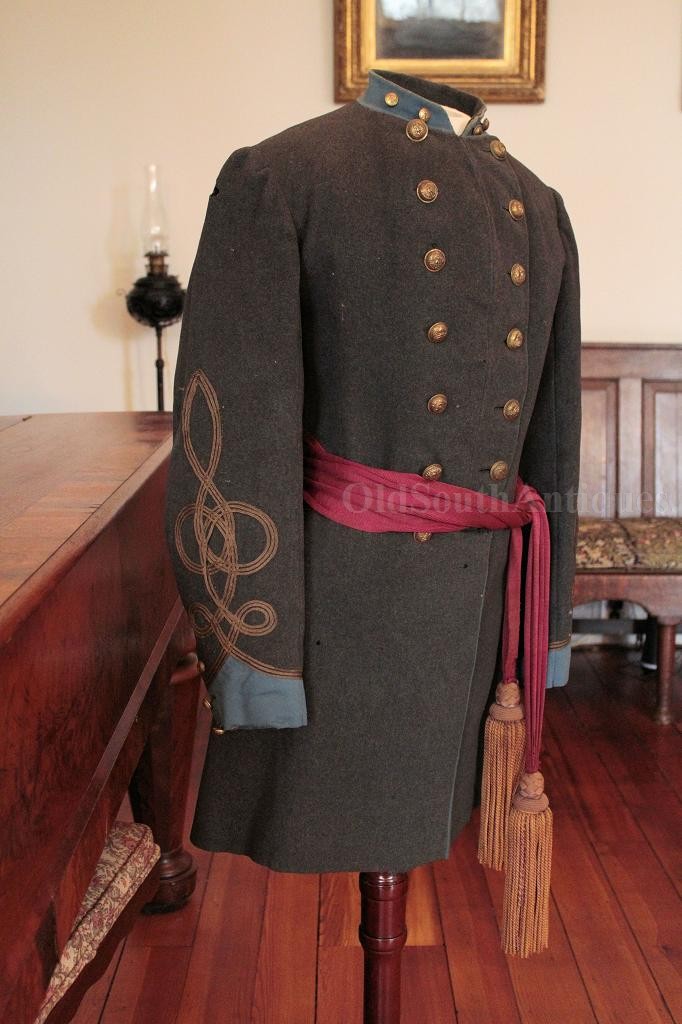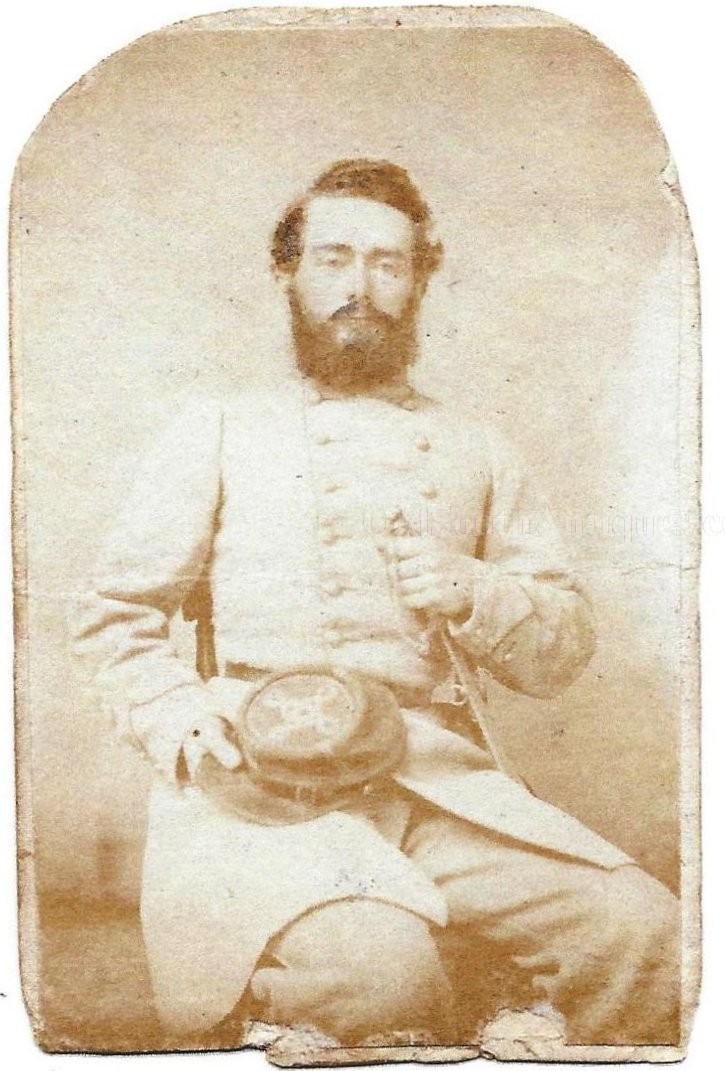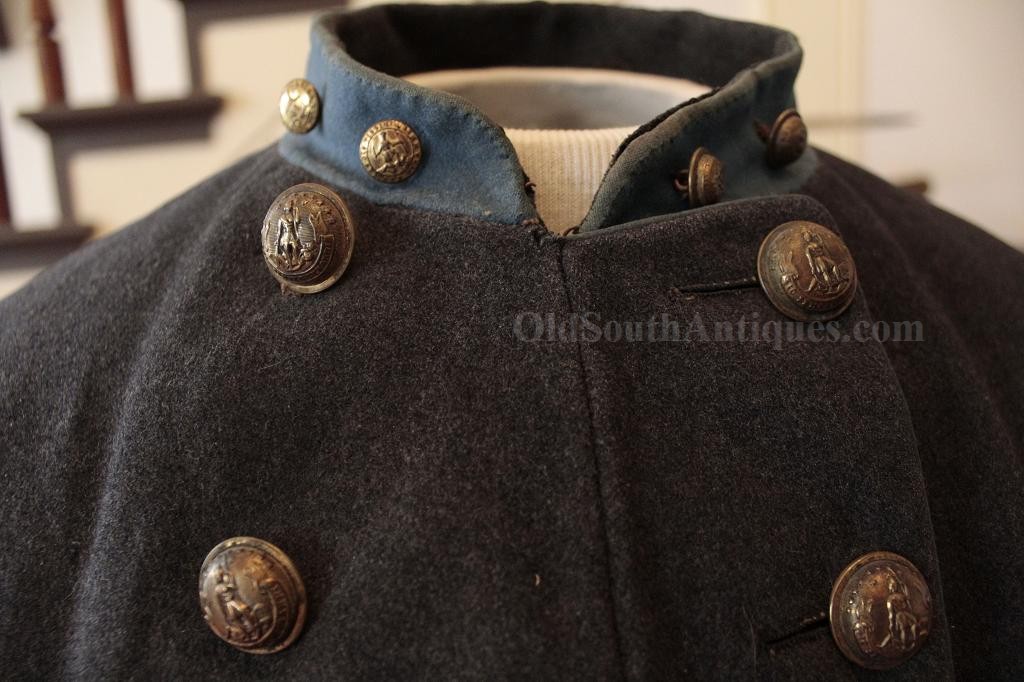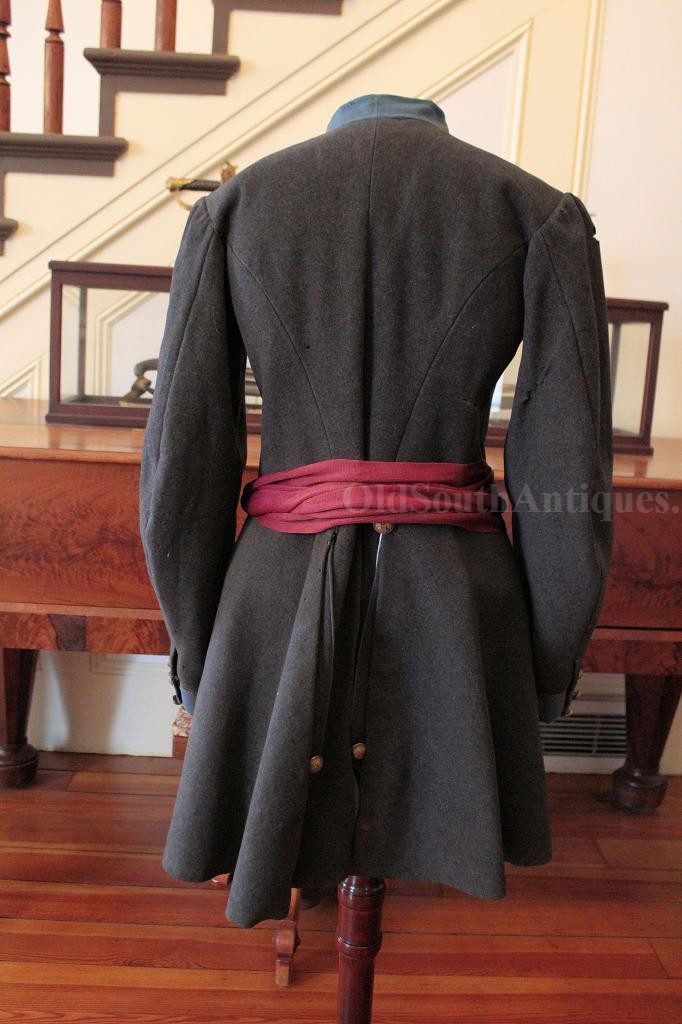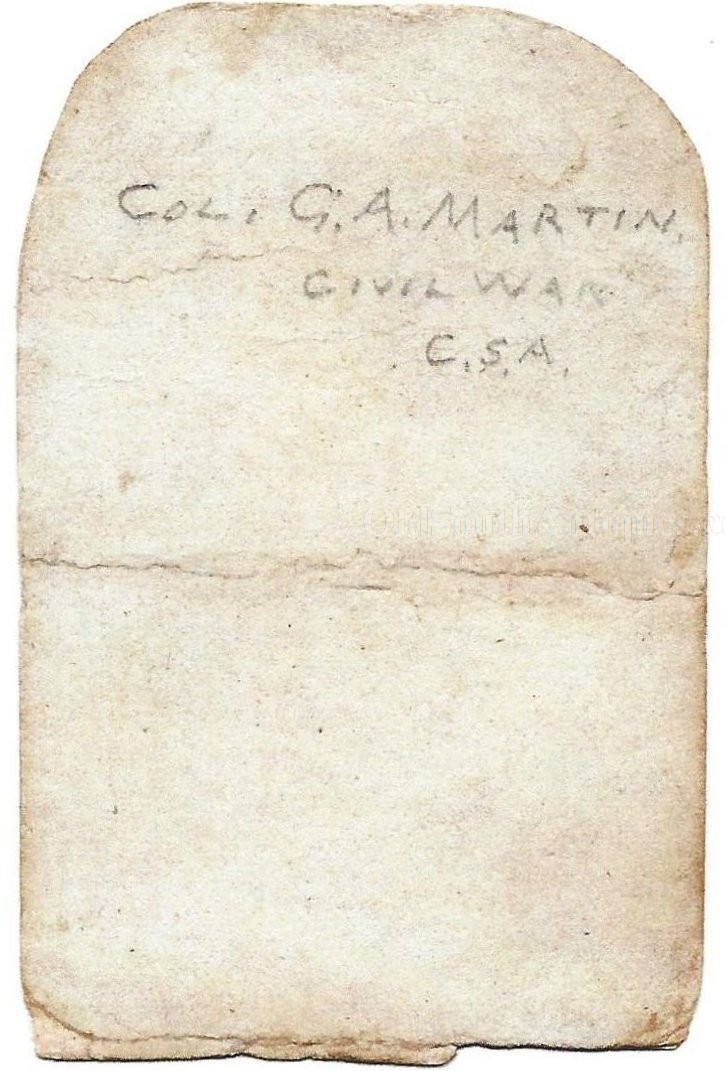
| Catalog | Past Items | Order Info | Terms/Conditions | About Us | Inventory Clearance |
This frock is well known to have come from the Bill Turner Collection. When Bill (now deceased) owned it, he also owned Lieutenant Colonel George Martin’s Virginia officer’s belt and various documents, which he sold separately. After Bill’s death, the identification was lost, but thankfully I was contacted by the collector who had purchased George Martin’s belt to inform me that he was familiar with this coat when Bill Turner owned it, and he proceeded to inform me that it had been worn by the same Lieutenant Colonel as the belt that he now owned. I afterwards tracked down the image shown here which had been sold to another collector, and while I do not have the original image, the owner kindly gave me a copy. So fortunately, with the help of the collector community, Colonel Martin’s identification has been firmly re-established.
The son of Colonel James Green Martin and Maacah Foreman, Martin studied law at the University of Virginia and immediately made the bar, practicing until he answered Virginia’s call. In April of 1861 the 27 year old raised a company, the Saint Bride's Light Artillery, which became Company B, 20th Battalion Virginia Heavy Artillery. He was transferred to Company I, 38th Virginia Infantry on April 25, 1864.
Colonel Martin's war diary is at the Virginia Historical Society. Many of his other papers are at the University of North Carolina. The following notes come from his papers. Martin had been ordered to organize the defense of Lynchburg, and the Battle of Lynchburg was fought on June 17–18, 1864; Martin wrote of it: "Lynchburg may be mentioned with Thermopylae & the Alamo.” On hearing of the evacuation, "I have no time to lose then, I replied, as I sprang up and commenced putting on my uniform, and thought, as I buckled on my sword & revolver, I will try & join my men, and if necessary die with them.” Later writing, "There a great many ‘Buffaloes’ in the area, who have committed great outrages… (the common way of saying rape at the time). I rode in the darkness with my pistol drawn.”
Whatever the trials, or howsoever dark the future looked, the Southern patriot was yet unwilling to surrender. At the surrender of the Army, he was ordered to dismiss his command, writing, "I would not surrender w/Lee and will not with Johnston.” It was his "intention to travel, with or near, the president in his retreat, so long as my services may be of use to him” and Martin "thereupon reported to Jefferson Davis & offered my services to him for such duty as he should deem proper. He accepted the offer, and my staff & such other officers as may be willing, are to be immediately armed & serve under my command as the immediate guard of the president. Burton (the president’s secretary) issued orders to furnish arms as I may suggest… I selected the Henry rifle.” The rifle with inscription, given by Burton Harrison to Colonel Martin, was in the Museum of the Confederacy when it still existed. He further wrote: "men had rifles supplemented w/Colt’s w/o swords. As an emblem of rank, I shall require the service of mine.”
Later the noble hearted president tried to dissuade Martin and his men from running such a risk on the president’s account, Martin writing, "The Pres has reconsidered the matter of accepting my command which is composed of Commissioned Officers, on the grounds that he would dislike to sacrifice such a devoted band of chivalrous gentlemen in his defense.”
He rode with Davis to Georgia; when the Confederate treasury was distributed, he refused pay. He then headed west alone, trying to make Mexico. He was captured in Augusta and sent to Old Point Comfort. After the War he resumed his practice, now though, in New York City. It became large and influential with an excellent reputation. He returned to Virginia for her climate. He married Georgie Alice Wickens in 1857. He served in the State Senate and the House of Delegates.
He died in Norfolk, Virginia, January 15, 1915 a much respected soldier and successful businessman.
His Double Breasted Frock coat shown here follows Confederate regulations for a Lieutenant Colonel of Infantry. There are seven, large Virginia state seal buttons in each row on the front of the coat (one is currently missing from the bottom of the left row). These buttons are back marked "EXTRA QUALITY". The coat has the sky blue collar and cuff facings of an infantry officer, and the coat is piped down the front edge with a 1/8" wide, rolled strip of woolen broadcloth, sky blue in color. This piping is the same as the material used for the collar and cuffs.
The three cuff buttons on each cuff are small Virginia state seals, back marked "EXTRA QUALITY". The sleeves are adorned with three strands of 3/8" flat gold braid, denoting the rank of Confederate Colonel. The sleeves are lined in an unbleached (or at least dirty) cotton shirting, tabby weave.
The collar has an interesting variation of insignia, instead of two stars on each side; it has two small Virginia buttons. The two on the right side have no rim and are back marked "W.H. HORSTMANN & SONS," while the two on the left side do have a rim and are back marked "SCOVILL MF'G CO. WATERBURY".
The rear of the coat is cut in conventional frock coat style, with the back vent and the pocket flaps piped in sky blue. The tails had four Virginia state seal buttons, two at the waist and two at the ends of the pocket flaps, back marked the same as the other large buttons. One is now missing.
The coat is interlined in the front panels of the body with the same gray woolen material as the coat is made of, and is further interlined with a layer of canvas next to the outer shell of the coat; a second layer of wool and cotton, and a layer of cotton waste.
The actual coat lining, for both the upper body and the skirts, is made of worsted and cotton, in a green and brown, tabby weave, overall a greenish color. The coat has been extensively patched, contemporary with its wartime use. There is one pocket in the left inside breast of the coat, roughly 5" across, the pocket bag made of unbleached cotton osnaburg; the tail pocket bags are made of this same material.
This is a reasonably well tailored frock coat, but instead of officer quality cloth, is made largely from material acquired at a Confederate Quartermaster Depot. The main coat cloth is the type purchased in England for Confederate enlisted men, and the pocket bags are made of the same cotton osnaburg found in enlisted coat linings. The use of what may be U.S. artillery or cavalry jacket lining is most interesting, and is a further example of materials that are not officer quality. The use of Virginia buttons to substitute for what were Lieutenant Colonel’s stars is a fascinating interpretation of the regulations. Finally, the extensive patching indicates a coat that has seen hard field use.
This is an excellent example of a rare, regulation Lieutenant Colonel of infantry, field officer's coat that saw extensive use during the War by one of Virginia’s gallant officers. The coat has some minor moth damage, and one dime sized hole in the right sleeve, but remains in very good condition and the color of the infantry blue facings remains bright.Copyright © 2025 OldSouthAntiques.com All Rights Reserved.
Privacy Policy | Terms of Use
Powered by Web-Cat Copyright © 1996-2025 GrayCat Systems
